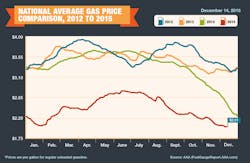Gas Prices Drop To Lowest Mark Since 2009
(WASHINGTON, December 14, 2015) U.S. drivers are paying the lowest average price for regular unleaded gasoline since 2009, and the national average is one cent away from dropping below $2 per gallon. These lower gas prices have been largely driven by the falling price of crude oil, which begins this week at its lowest mark in more than five years. U.S. average gas prices are 79 per gallon less than the 2015 peak, and the national average has moved lower for 33 of the past 38 days for a total savings of 21 cents per gallon. The average price at the pump is down two cents on the week, 16 cents on the month and 54 cents on the year.
The price of West Texas Intermediate crude oil, the traditional U.S. benchmark, closed out last week with a Friday settlement of $35.62 per barrel, a price not seen since the 2008-2009 Great Recession. Crude oil has tumbled approximately 60 percent compared to June 2014 as global supply continues to outpace demand. This imbalance is likely to continue into 2016, which should keep a ceiling on oil prices. Barring any disruptions in supply, consumers are expected to continue to benefit from noticeable fuel savings.
Retail averages are below $2 per gallon in 26 states. South Carolina ($1.79), Missouri ($1.79) and Kansas ($1.79) are the nation’s least expensive markets, and drivers in these states are saving nearly $1 per gallon compared to the state with the highest average, which is Hawaii ($2.75). California ($2.65), Nevada ($2.49), Washington ($2.42) and Alaska ($2.39) round out the top five most expensive markets for gasoline.
Gas prices are holding relatively steady and have moved by +/- 3 cents or less in 29 states and Washington, D.C. week-over-week. Consumers in 43 states and Washington, D.C. have seen prices fall over this same period, and averages are down a nickel or more per gallon in six states, led by: Delaware (-8 cents), Minnesota (-6 cents) and North Dakota (-6 cents). Averages in seven states have moved higher on the week, led by Michigan (+8 cents).
Averages have fallen nationwide month-over-month, and with the exception of Alaska (-1 cent), consumers are benefitting from monthly savings of more than a nickel per gallon in the price of retail gasoline. Pump prices are down double-digits in 41 states and Washington, D.C. versus one month ago, and drivers in eight states are saving a quarter or more per gallon. The largest monthly discounts are in the Midwestern states of Wisconsin (-36 cents), Minnesota (-30 cents) and Michigan (-30 cents).
Pump prices typically fall during the winter months due to reduced demand for gasoline. Motorists nationwide continue to experience year-over-year savings, though today’s average is the smallest year-over-year savings of 2015. Alaska (-99 cents) and Hawaii (-96 cents) are the only two states where averages are down by more than 75 cents per gallon year-over-year. Consumers in 42 states and Washington, D.C. are saving 50 cents or more per gallon versus this same date last year, and California (-23 cents) is the only state posting a yearly savings of less than a quarter per gallon.
With both Brent and WTI reaching their cheapest levels since the global economic crisis, attention is now focused on the Federal Reserve’s potential action to raise interest rates. A strong U.S. jobs report has contributed to rumors that the Fed may increase its rate for the first time since 2008, which could further impact the global oil market. An increase in interest rates would be expected to result in a stronger U.S. dollar, which in turn makes oil (priced in U.S. dollars) a relatively more expensive investment for those holding other currencies, making it a less attractive investment. This could further exacerbate the market’s current oversupply and keep downward pressure on the global price of crude oil.
The U.S. oil rig count fell by its largest weekly increment in nearly three months (28 rigs), though strong production continues to oversupply the market. Members of Congress are also working on a budget deal that could include an end to the decades-old ban on U.S. crude oil exports. An end to the ban would allow unprocessed crude oil produced in the U.S. to enter the global oil market, which could impact both domestic production and global supply.
WTI opened the trading session below $35 per barrel. At the close of Friday’s formal trading session on the NYMEX, WTI was down $1.14 and settled at $35.62 per barrel. This closing price represented a loss of nearly ten percent on the week.
Motorists can find current gas prices along their route with the free AAA Mobile app for iPhone, iPad and Android. The app can also be used to map a route, find discounts, book a hotel and access AAA roadside assistance. Learn more at AAA.com/mobile.
